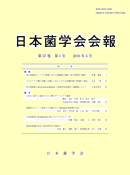
- Issue 4
- Issue 3 Pages 177-
- Issue 2 Pages 105-
- Issue 1 Pages 33-
- |<
- <
- 1
- >
- >|
-
Shigeru KANEKO2001Volume 42Issue 3 Article ID: jjom.H12-137
Published: 2001
Released on J-STAGE: October 13, 2020
JOURNAL FREE ACCESSThis paper reviews studies on the taxonomy and ecology of parasitic fungi, especially those parasitic on woody plants, conducted by the author. These studies cover the following five subjects: 1) evaluation of taxonomic criteria of rust fungi at the species level, and the revision of taxonomy in several groups of rust fungi; 2) elucidation of the heteroecism of rust fungi; 3) the elucidation of the conditions determining the germination type of basidiospores in rust fungi, and nuclear behavior in germinating basidiospores; 4) taxonomy and identification of ascomyceteous and coelomyceteous parasitic fungi on woody plants; and 5) elucidation of the ecology and function of ascomyceteous and coelomyceteous parasitic fungi on woody plants. In rust fungi, taxonomic revisions based on several new taxonomic criteria are described, particularly with respect to melampsoraceous rust groups. The positive results of experiments on heteroecism are also summarized. In ascomyceteous and coelomyceteous parasitic fungi on woody plants, studies on parasitic fungi on fagaceous trees, blue stain fungi, and endophytic fungi are reviewed. The necessity of further experiments to clarify the various functions of parasitic fungi is emphasized for the preservation of healthy forest ecosystems.
View full abstractDownload PDF (1714K) -
Izumi OKANE2001Volume 42Issue 3 Article ID: jjom.H12-149
Published: 2001
Released on J-STAGE: October 13, 2020
JOURNAL FREE ACCESSStudies on the taxonomy and ecology of endophytic fungi of ericaceous plants, mangrove trees, and chenopodiaceous halophytes have afforded biological information on not only endophytic fungi, but also fungi known as saprophytes or plant pathogens. In the course of the studies, three new taxa living in plant tissues were described, Guignardia endophyllicola (anamorph Phyllosticta capitalensis, Mycosphaerellaceae) and Discostroma tricellulare (anamorph Seimatosporium azaleae, Amphisphaeriaceae) from ericaceous plants, and Surculiseries rugispora (mitosporic fungi, Xylariaceae) from Bruguiera gymnorrhiza. These studies also revealed several ecological phenomena: 1) successional changes and life cycles of major endophytes of ericaceous plants, 2) the broad host range and distribution of G. endophyllicola, 3) the site-specificity of flora of endophytes on B. gymnorrhiza, and 4) the host-preference and universality of flora of endophytes on Salicornia europaea and other chenopodiaceous plants growing in salt marshes. Such information acquired from studies on endophytic fungi contributes to clarification of the diversity of fungi associated with plants.
View full abstractDownload PDF (1181K)
-
Takezi HASEGAWA2001Volume 42Issue 3 Article ID: jjom.H12-163
Published: 2001
Released on J-STAGE: October 13, 2020
JOURNAL FREE ACCESSThis paper outlines the history of studies in yeast taxonomy in the 19th and 20th centuries, from the discovery of yeast as an alcohol-fermenting agent to the current state of classification of the yeast genera. Studies on ascomycetous and basidiomycetous yeasts are covered, as well as on yeasts in the mitosporic fungi, which are necessary to construct the historical view of the field.
View full abstractDownload PDF (708K)
-
[in Japanese]2001Volume 42Issue 3 Pages 177-187
Published: 2001
Released on J-STAGE: March 06, 2024
JOURNAL FREE ACCESSDownload PDF (1982K)
- |<
- <
- 1
- >
- >|